Combining Co-Benefits and Stakeholders Perceptions into Green Infrastructure Selection for Flood Risk Reduction
Abstract
:1. Introduction
2. Linking Green Infrastructure, Co-Benefits, Ecosystem Services, and Human Well-Being
2.1. Ecosystem Services and Human Well-Being
2.2. Ecosystem Services and Green Infrastructure
2.3. Green Infrastructure and Co-Benefits
- Groundwater recharge: GI that allow infiltration provide groundwater recharge, which is important where groundwater levels are reduced because of over abstraction or dry conditions [30].
- Recreation: green spaces are important for human recreation in open spaces. Having access to green spaces reduces health issues and improves well-being [32].
- Health: WHO [32] recommends at least 10 m2 of green spaces per inhabitant in urban areas. Physical activity in natural environments helps to reduce mental health issues.
- Food security: the creation of urban farming spaces in green areas and green roofs is considered a strategy to improve food security in the cities [5].
- Rainwater harvesting: water collected through rainwater barrels can be used for outdoor irrigation, reducing significantly the use of potable water [30].
- Pumping and treatment reduction: by reducing the runoff, the amount of water to combined drainage networks is reduced, decreasing the pumping and wastewater treatment costs [30].
3. Methodology
3.1. Co-Benefits Classification
3.2. Establishing Indicators to Assess the Co-Benefits
4. Study Area
5. Results and Discussion
5.1. Land Use Analysis and Applicable GI Measures
5.2. Identification of the Main Co-Benefits to be Enhanced
5.3. Definition of the Most Effective Combinations of GI
6. Conclusions
Acknowledgments
Author Contributions
Conflicts of Interest
Appendix A
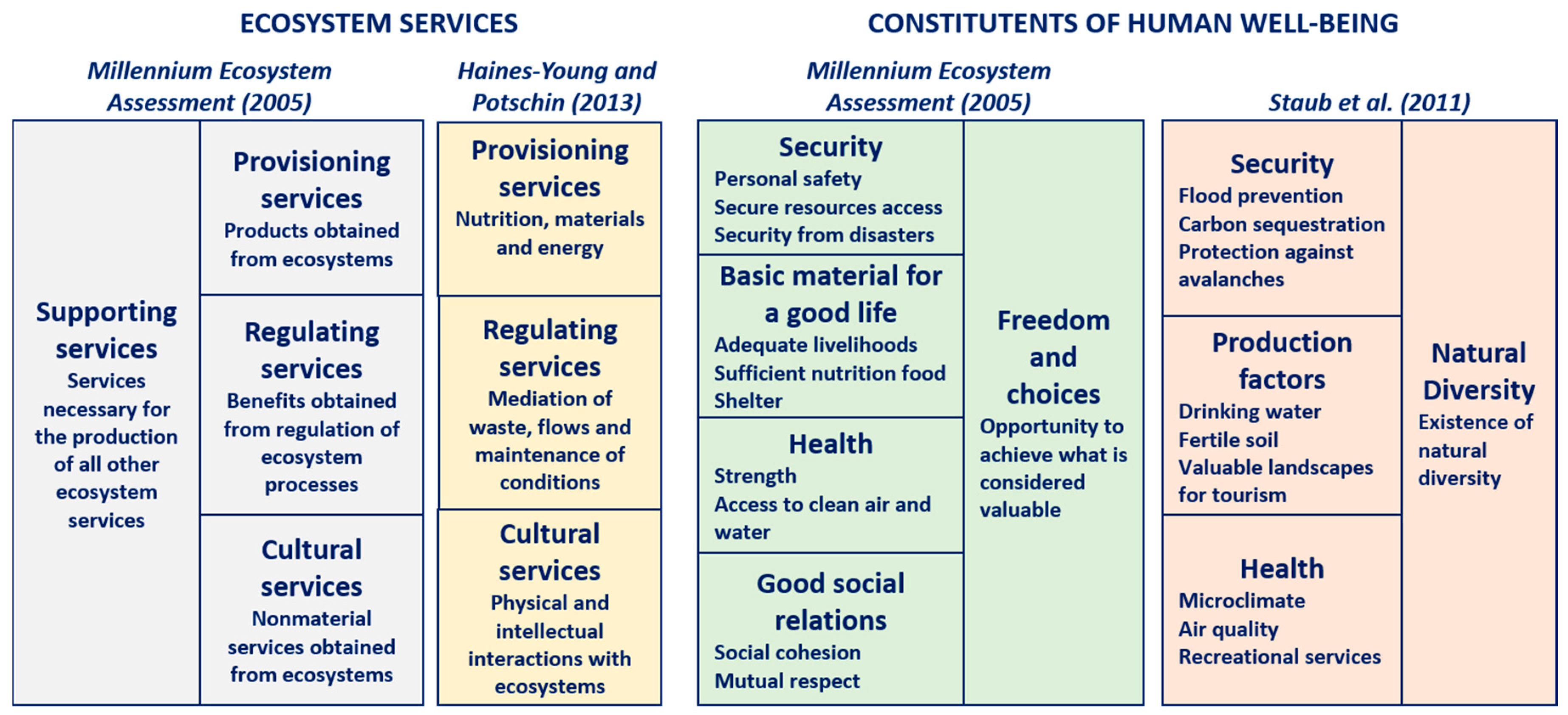

Appendix B
- Select the type of stakeholder that best describes your position
- National level government
- Local level government
- Environmental or utility authority
- NGO or similar
- Researcher
- Consultant
- Inhabitant
- Commercial owner
- Tourist
- Which is the most important environmental benefit that should be enhanced in the area by the application of green infrastructure?
- Water quality of receiving bodies
- Groundwater recharge
- Biodiversity and ecology enhancement
- Temperature reduction (heat stress reduction)
- Air quality improvement
- Which is the most important social benefit that should be enhanced in the area by the application of green infrastructure?
- Amenity and aesthetics
- Recreation and health (increment of green area per inhabitant)
- Food security
- Which is the most important economic benefit that should be enhanced in the area by the application of green infrastructure?
- Rainwater harvesting
- Pumping and treatment reduction
- Saving energy in buildings
- Real estate value appreciation
- What is the level of contribution of stormwater runoff to the pollution and degradation of water bodies?
- High
- Medium
- Low
- Not applicable
- What is the current usage of groundwater extraction and water table depletion?
- High
- Medium
- Low
- Not applicable
- What is the need of enhancement of biodiversity and ecology in the urban area?
- High
- Medium
- Low
- Not applicable
- What is the level of impact of heat stress effect on the population in the urban area?
- High
- Medium
- Low
- Not applicable
- What is the importance of improving air quality in the urban area?
- High
- Medium
- Low
- Not applicable
- What is the requirement of landscape improvement by including more natural spaces to enhance amenity and livability of the community?
- High
- Medium
- Low
- Not applicable
- What is the importance of producing food in the area to enhance food security?
- High
- Medium
- Low
- Not applicable
- What is the importance of reducing water demand by using alternative water sources such as rainwater harvesting?
- High
- Medium
- Low
- Not applicable
- What is the importance of reducing pumping and treatment of stormwater in the area?
- High
- Medium
- Low
- Not applicable
- What is the importance of reducing energy consumption in buildings by reducing air conditioner and ventilation systems demand?
- High
- Medium
- Low
- Not applicable
- What is the importance of increasing real estate value in the urban area?
- High
- Medium
- Low
- Not applicable
References
- Intergovernmental Panel on Climate Change (IPCC). Managing the Risks of Extreme Events and Disasters to Advance Climate Change Adaptation. A Special Report of Working Groups I and II of the Intergovernmental Panel on Climate Change; Field, C.B., Barros, V., Stocker, T.F., Qin, D., Dokken, D.J., Ebi, K.L., Mastrandrea, M.D., Mach, K.J., Plattner, G.-K., Allen, S.K., et al., Eds.; Cambridge University Press: Cambridge, UK; New York, NY, USA, 2012.
- Mynett, A.E.; Vojinovic, Z. Hydroinformatics in multi-colours—Part red: Urban flood and disaster management. J. Hydroinform. 2009, 11, 166. [Google Scholar] [CrossRef]
- CIRIA. Demonstrating the Multiple Benefits of SuDS—A Business Case. Available online: http://www.susdrain.org/files/resources/ciria_guidance/ciria_rp993_literature_review_october_2013_.pdf (accessed on 22 November 2015).
- European Commission. The Multifunctionality of Green Infrastructure, In-depth Report; European Commission’s Directorate-General Environment: Brussels, Belgium, 2012. [Google Scholar]
- Center for Neighborhood Technology & American Rivers. The Value of Green Infrastructure: A Guide to Recognizing Its Economic, Environmental and Social Benefits; Center for Neighborhood Technology: Chicago, IL, USA, 2010. [Google Scholar]
- Yazdanfar, Z.; Sharma, A. Urban drainage system planning and design—Challenges with climate change and urbanization: a review. Water Sci. Technol. 2015, 72, 165–179. [Google Scholar] [CrossRef] [PubMed]
- Vojinovic, Z. Flood Risk: The Holistic Perspective. From Integrated to Interactive Planning for Flood Resilience; IWA Publishing: London, UK, 2015. [Google Scholar]
- Lundy, L.; Wade, R. Integrating sciences to sustain urban ecosystem services. Prog. Phys. Geogr. 2011, 35, 653–669. [Google Scholar] [CrossRef]
- Martin, C.; Ruperd, Y.; Legret, M. Urban stormwater drainage management : The development of a multicriteria decision aid approach for best management practices. Eur. J. Oper. Res. 2007, 181, 338–349. [Google Scholar] [CrossRef]
- Cheng, M.; Zhen, J.X.; Shoemaker, L. BMP decision support system for evaluating stormwater management alternatives. Front. Environ. Sci. Eng. China 2009, 3, 453–463. [Google Scholar] [CrossRef]
- Young, K.D.; Dymond, R.L.; Asce, M.; Kibler, D.F.; Asce, M. Development of an Improved Approach for Selecting Storm-Water Best Management Practices. J. Water Resour. Plan. Manag. 2011, 137, 268–275. [Google Scholar] [CrossRef]
- Jia, H.; Yao, H.; Tang, Y.; Yu, S.L.; Zhen, J.X.; Lu, Y. Development of a multi-criteria index ranking system for urban runoff best management practices ( BMPs ) selection. Environ. Monit. Assess. 2013, 185, 7915–7933. [Google Scholar] [CrossRef] [PubMed]
- Chow, J.; Savic, D.; Fortune, D.; Kapelan, Z.; Mebrate, N. Translating legislative requirements and best practice guidance into a systematic, multi-criteria decision support framework for effective sustainable drainage design evaluation. In Proceedings of the 2013 IAHR World Congress, Chengdu, China, 8–13 September 2013. [Google Scholar]
- Meerow, S.; Newell, J.P. Spatial planning for multifunctional green infrastructure: Growing resilience in Detroit. Landsc. Urban Plan. 2016, 159, 62–75. [Google Scholar] [CrossRef]
- Schifman, L.A.; Herrmann, D.L.; Shuster, W.D.; Ossola, A.; Garmestani, A.; Hopton, M.E. Situating Green Infrastructure in Context: A Framework for Adaptive Socio-Hydrology in Cities. Water Resour. Res. 2017, 1–16. [Google Scholar] [CrossRef]
- Alves, A.; Sanchez, A.; Vojinovic, Z.; Seyoum, S.; Babel, M.; Brdjanovic, D. Evolutionary and holistic assessment of green-grey infrastructure for CSO reduction. Water 2016, 8, 402. [Google Scholar] [CrossRef]
- Jia, H.; Lu, Y.; Yu, S.L.; Chen, Y. Planning of LID–BMPs for urban runoff control: The case of Beijing Olympic Village. Sep. Purif. Technol. 2012, 84, 112–119. [Google Scholar] [CrossRef]
- Fratini, C.F.F.; Geldof, G.D.; Kluck, J.; Mikkelsen, P.S. Three Points Approach (3PA) for urban flood risk management: A tool to support climate change adaptation through transdisciplinarity and multifunctionality. Urban Water J. 2012, 9, 317–331. [Google Scholar] [CrossRef] [Green Version]
- Moura, N.C.B.; Pellegrino, P.R.M.; Martins, J.R.S. Best management practices as an alternative for flood and urban storm water control in a changing climate. J. Flood Risk Manag. 2016, 9, 243–254. [Google Scholar] [CrossRef]
- Recanatesi, F.; Petroselli, A.; Ripa, M.N.; Leone, A. Assessment of stormwater runoff management practices and BMPs under soil sealing: A study case in a peri-urban watershed of the metropolitan area of Rome (Italy). J. Environ. Manage. 2017, 201, 6–18. [Google Scholar] [CrossRef] [PubMed]
- Tzoulas, K.; Korpela, K.; Venn, S.; Yli-pelkonen, V.; Ka, A.; Niemela, J.; James, P. Promoting ecosystem and human health in urban areas using Green Infrastructure : A literature review. Landsc. Urban Plan. 2007, 81, 167–178. [Google Scholar] [CrossRef]
- Haines-Young, R.H.; Potschin, M.B. The links between biodiversity, ecosystem services and human well-being. In Ecosystems Ecology: A New Synthesis, Chapter Six; Cambridge University Press: Cambridge, UK, 2010. [Google Scholar]
- Millennium Ecosystem Assessment. Ecosystems and Human Well-Being: Synthesis; Island Press: Washington, DC, USA, 2005; Volume 5. [Google Scholar]
- Department for Environment, Food and Rural Affairs (Defra), UK. An Introductory Guide to Valuing Ecosystem Services; Department for Environment, Food & Rural Affairs: London, UK, 2007.
- Consultation on CICES (Common International Classification of Ecosystem Services) Version 4, August–December 2012 and CICES-V4-3 Spreadsheet. Available online: https://cices.eu/resources/ (accessed on 12 December 2017).
- De Groot, R.S.; Wilson, M.A.; Boumans, R.M.J. A typology for the classification, description and valuation of ecosystem functions, goods and services. Ecol. Econ. 2002, 41, 393–408. [Google Scholar] [CrossRef]
- Staub, C.; Ott, W.; Heusi, F.; Klingler, G.; Jenny, A.; Häcki, M.; Hauser, A. Indicators for Ecosystem Goods and Services: Framework, Methodology and Recommendations for a Welfare-Related Environmental Reporting; Federal Office for the Environment (FOEN): Bern, Switzerland, 2011. [Google Scholar]
- Woods-Ballard, B.; Kellagher, R.; Martin, P.; Jefferies, C.; Bray, R.; Shaffer, P. The SUDS Manual; CIRIA: London, UK, 2007. [Google Scholar]
- UDFCD. Urban Storm Drainage Criteria Manual Volume 3, Stormwater Best Management Practice; Urban Drainage, Flood Control District, Eds.; Water Resources Publications: Denver, CO, USA, 2010.
- Horton, B.; Digman, C.J.; Ashley, R.M.; Gill, E. BeST (Benefits of SuDS Tool) W045c BeST—Technical Guidance Release Version 3; CIRIA: London, UK, 2016. [Google Scholar]
- Lovell, S.T.; Taylorm, J.R. Supplying urban ecosystem services through multifunctional green infrastructure in the United States. Landsc. Ecol. 2013, 1447–1463. [Google Scholar] [CrossRef]
- WHO. Health and Sustainable Development. Available online: http://www.who.int/sustainable-development/cities/health-risks/urban-greenspace/%0Aen/ (accessed on 5 December 2015).
- Macmullan, E.; Reich, S. The Economics of Low-Impact Development: A Literature Review; ECONorthwest: Eugene, OR, USA, 2007. [Google Scholar]
- Derkzen, M.L.; Van Teeffelen, A.J.A.; Verburg, P.H. Quantifying urban ecosystem services based on high-resolution data of urban green space : An assessment for Rotterdam, The Netherlands. J. Appl. Ecol. 2015, 52, 1020–1032. [Google Scholar] [CrossRef]
- Jia, H.; Yao, H.; Tang, Y.; Yu, S.L.; Field, R.; Tafuri, A.N. LID-BMPs planning for urban runoff control and the case study in China. J. Environ. Manag. 2015, 149, 65–76. [Google Scholar] [CrossRef] [PubMed]
- Patiño Gómez, J. Assessment of Green Infrastructure Measures to Reduce Stormwater Runoff and Enhance Multiple Benefits in Urban Areas; Asian Institute of Technology: Bangkok, Thailand; UNESCO–IHE: Delft, The Netherlands, 2017. [Google Scholar]
- Shoemaker, L.; Riverson, J.J.; Alvi, K.; Zhen, J.X.; Paul, S.; Rafi, T. SUSTAIN—A Framework for Placement of Best Management Practices in Urban Watersheds to Protect Water Quality; National Risk Management Research Laboratory Office of Research and Development U.S. Environmental Protection Agency: Cincinnati, OH, USA, 2009.
- DEFRA. Local Action. Available online: http://urbanwater-eco.services/toolbox/ (accessed on 18 December 2016).
- Berghage, R.; Beattie, D.; Jarrett, A.R.; Thuring, C.; Razaei, F.; O’Connor, T.P. Green Roofs for Stormwater Runoff Control Green Roofs for Stormwater Runoff Control; National Risk Management Research Laboratory Office of Research and Development U.S. Environmental Protection Agency: Cincinnati, OH, USA, 2009.
- Lorphensri, O.; Ladawadee, A.; Dhammasarn, S. Review of groundwater management and land subsidence in Bangkok, Thailand. In Groundwater and Subsurface Environments; Taniguchi, M., Ed.; Springer: Tokyo, Japan, 2011. [Google Scholar]
- Keerakamolchai, W. Towards a Framework for Muntifunctional Flood Detention Facilities Design in a Mixed Land Use Area: The Case of Ayutthaya World Heritage Site, Thailand. Master's Thesis, Asian Institute of Technology, Bangkok, Thailand, UNESCO–IHE, Delft, The Netherlands, 2014. [Google Scholar]
- Golub, D. Towards a Framework for Participatory Flood Risk Assessment in Urban Areas with Cultural Heritage: The Case of the Historic City of Ayutthaya, Thailand; UNESCO-IHE Institute for Water Education: Delft, The Netherlands, 2014. [Google Scholar]
- Roachanakanan, T. Changing in drainage pattern and increasing flood risk in Thailand. In Proceedings of the Asia Flood Conference, Bangkok, Thailand, 29–31 October 2013. [Google Scholar]
- Vojinovic, Z.; Hammond, M.; Golub, D.; Hirunsalee, S.; Weesakul, S.; Meesuk, V.; Medina, N.; Sanchez, A.; Kumara, S.; Abbott, M. Holistic approach to flood risk assessment in areas with cultural heritage: A practical application in Ayutthaya, Thailand. Nat. Hazards 2016, 81, 589–616. [Google Scholar] [CrossRef]
- Vojinovic, Z.; Keerakamolchai, W.; Weesakul, S.; Pudar, R.S.; Medina, N.; Alves, A. Combining ecosystem services with cost-benefit analysis for selection of green and grey infrastructure for flood protection in a cultural setting. Environments 2016, 4, 3. [Google Scholar] [CrossRef]
- Cheng, C.; Ryan, R.L.; Warren, P.S.; Nicolson, C. Exploring Stakeholders’ Perceptions of Urban Growth Scenarios for Metropolitan Boston (USA): The Relationship Between Urban Trees and Perceived Density. Cities Environ. 2017, 10, 7. [Google Scholar]
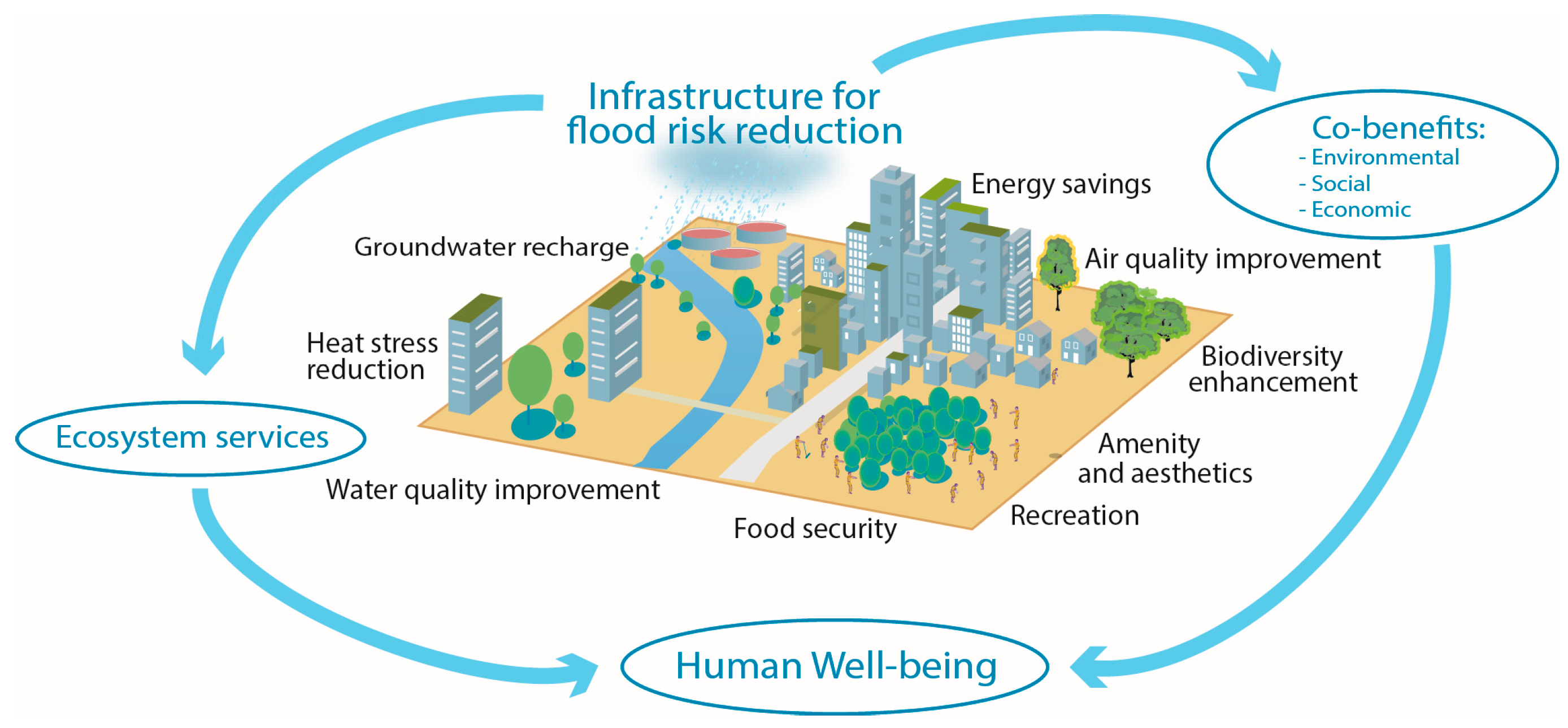
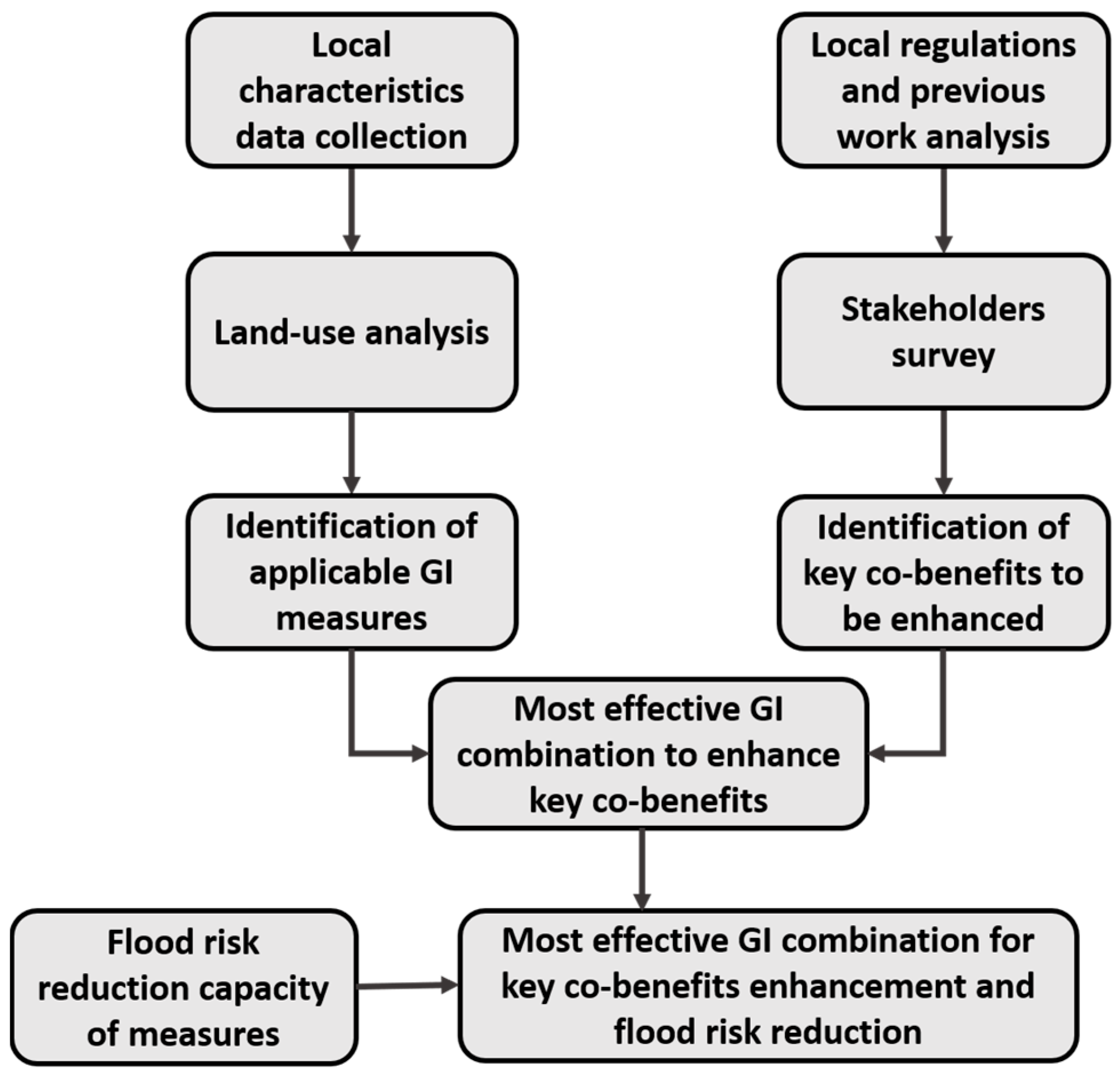

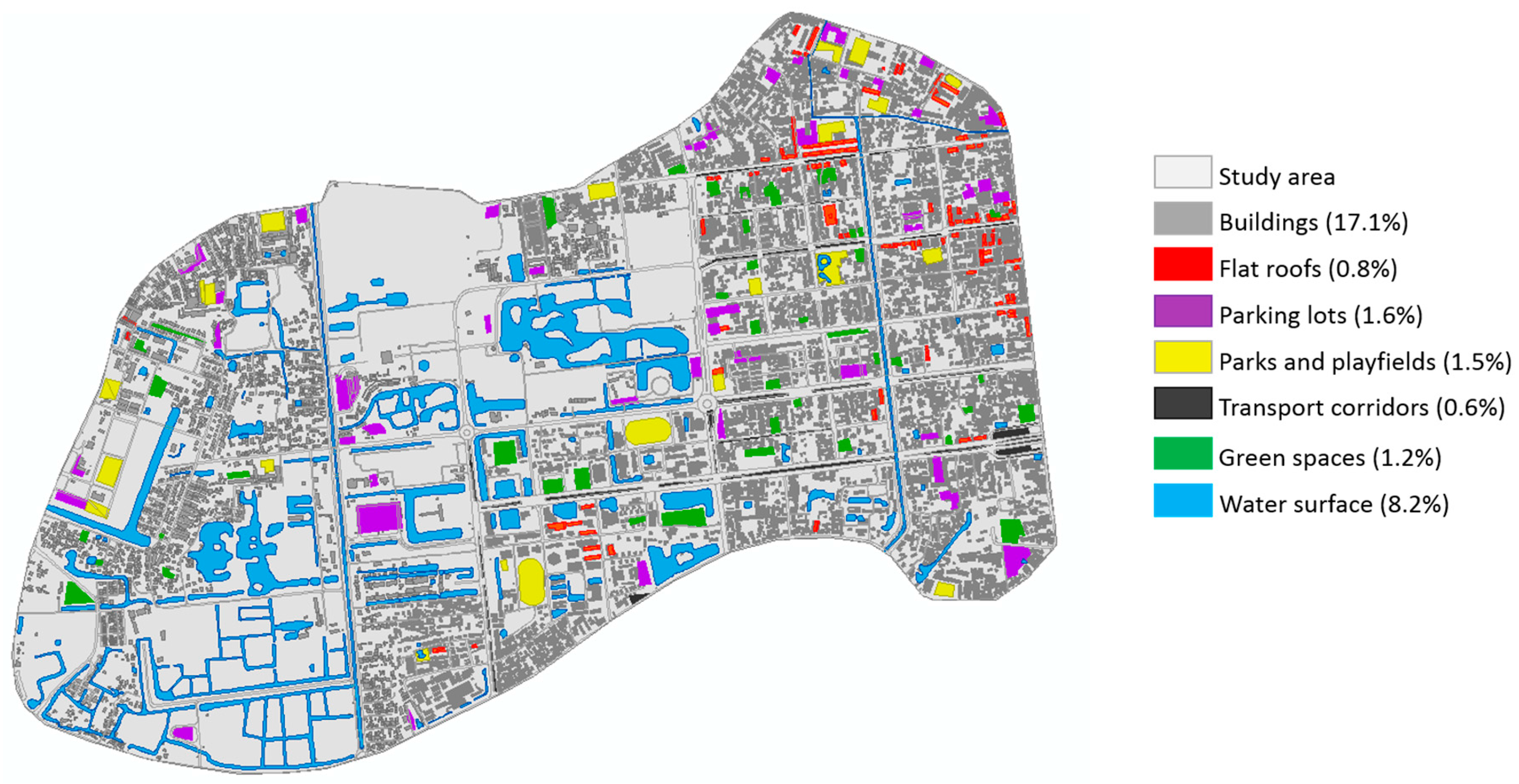
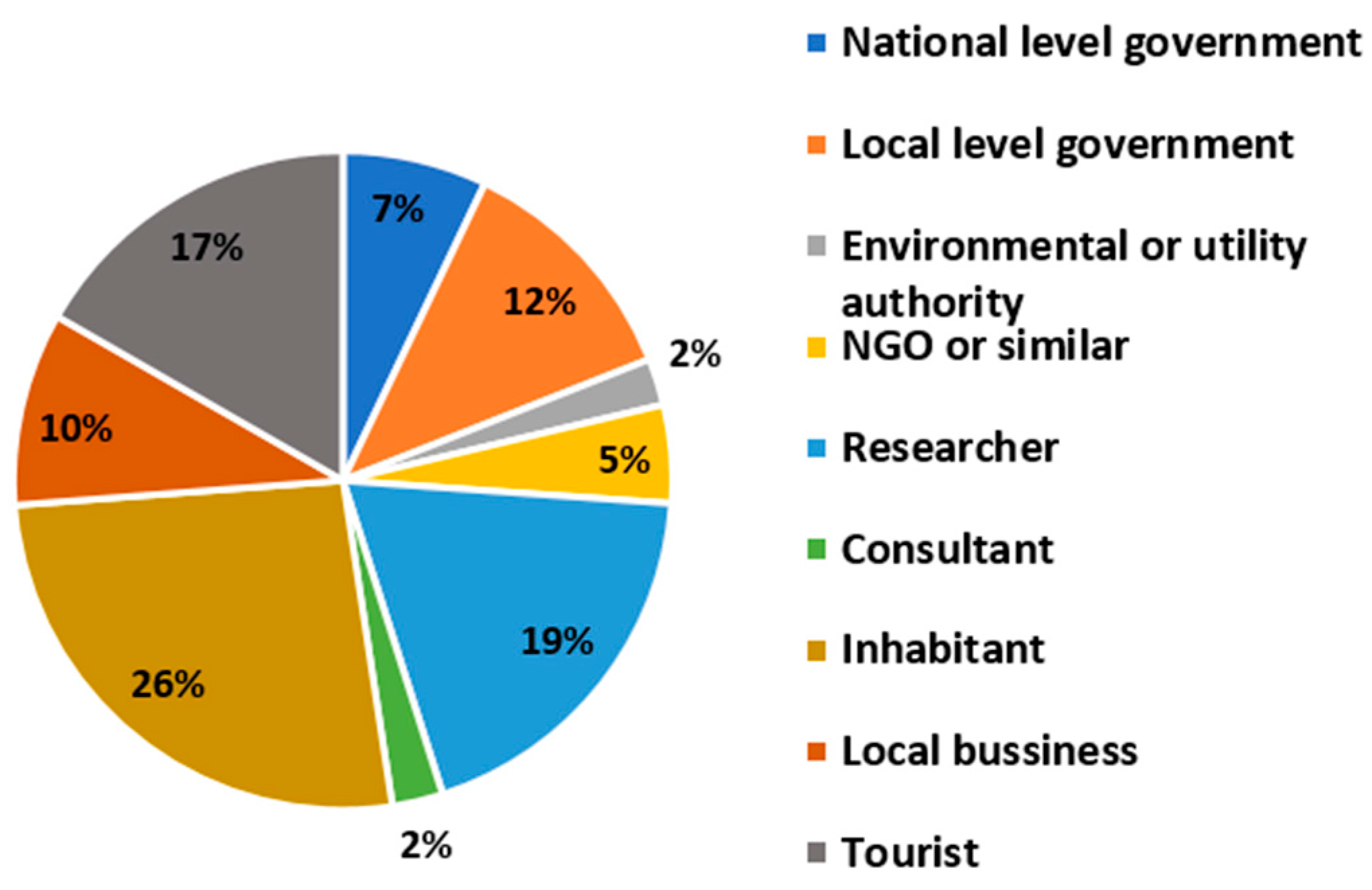


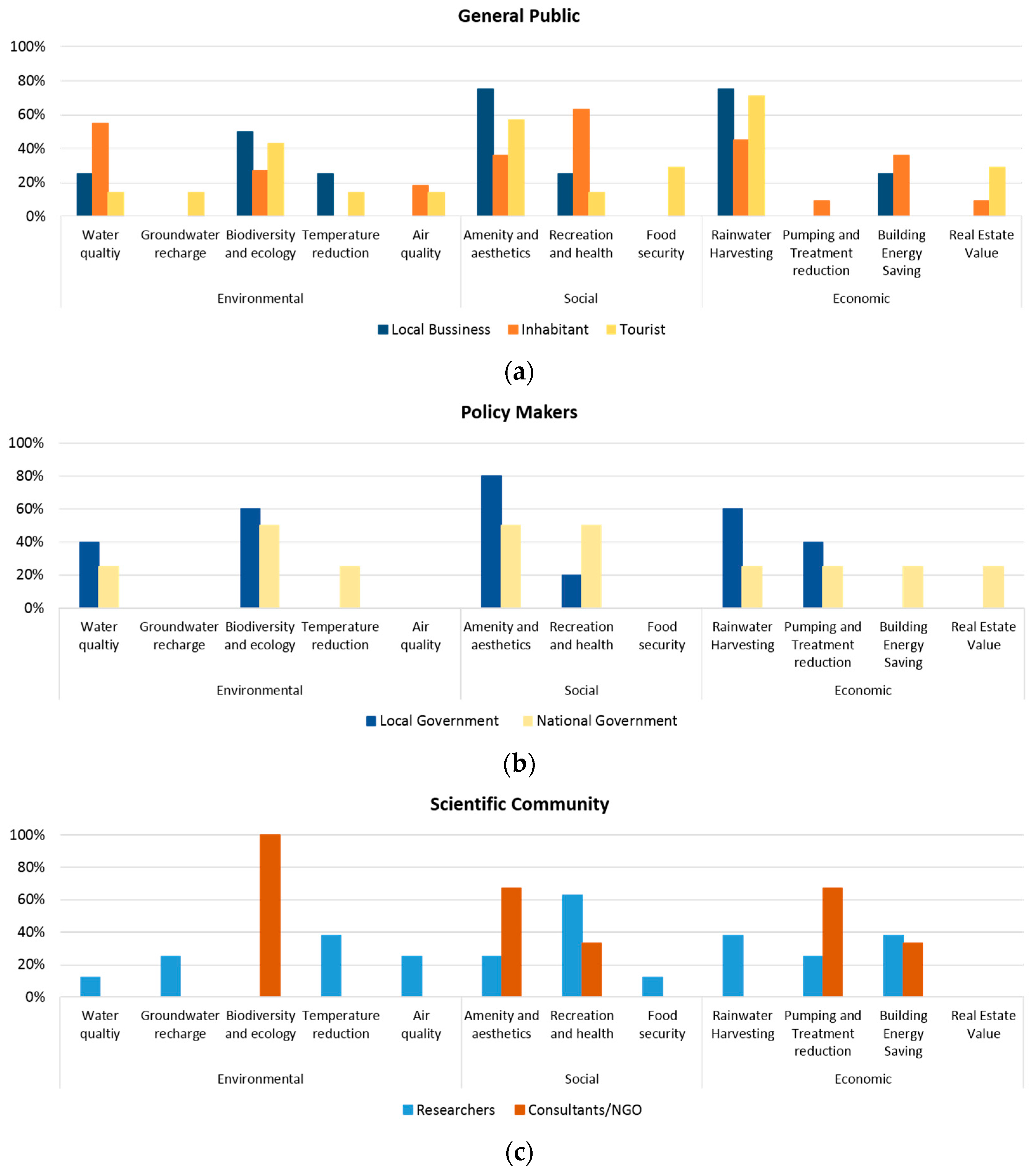
| Section | Division | Group | Class | Green Infrastructure |
|---|---|---|---|---|
| Provisioning | Nutrition | Biomass | Cultivated crops | Green spaces, green walls, green roofs |
| Wild Plants | Green spaces, wetlands, rain gardens | |||
| Wild Animals | Green spaces, wetlands, retentions ponds | |||
| Plants and algae from in-situ aquaculture | Retention ponds, open channels, wetlands | |||
| Animals from in-situ aquaculture | Retention ponds, open channels, urban wetlands | |||
| Water | Surface water for drinking uses | Rainwater harvesting, retention ponds | ||
| Groundwater for drinking uses | Infiltration surfaces, pervious pavements | |||
| Nutrients | Nutrients for plants | Urban agriculture, trees and parks, wetlands | ||
| Materials | Biomass | Fibres and other materials | Urban trees, green spaces and green roofs | |
| Water | Surface water for non-drinking uses | Rainwater harvesting, retention ponds, open channels | ||
| Groundwater for non-drinking uses | Infiltration surfaces and trenches, pervious pavements | |||
| Energy | Biomass-based energy sources | Plant-based sources | Urban trees, green spaces, green roofs | |
| Waste water-based sources | Wetlands, green spaces fertilization | |||
| Regulating and maintenance | Mediation of waste, toxics and other nuisances | Mediation by biota | Bio-remediation, filtration, sequestration, storage | Urban wetlands, retention ponds, buffering and bioretention areas |
| Mediation by ecosystems | Filtration/sequestration/storage by ecosystems | Urban wetlands, retention ponds, bio-swales, buffering and bioretention areas | ||
| Enhancement of pollutants removal systems | Green spaces, rain gardens, bio-swales, infiltration surfaces, retention ponds, wetlands | |||
| Mediation of smell, noise, visual impact | Green walls/facades, green spaces, green noise barriers, urban trees | |||
| Mediation of flows | Liquid flows | Hydrological cycle and water flow maintenance | Infiltration areas, trenches and pavements, rainwater disconnection, open channels | |
| Flood protection | Green measures allowing storage, infiltration, convey and imperviousness reduction | |||
| Combined Sewer Overflow reduction | Green measures allowing storage, infiltration and runoff flow reduction in general | |||
| Gaseous/air flows | Storm/wind protection | Green barriers, urban trees and forest | ||
| Ventilation and transpiration | Urban parks and forest, green spaces, rain gardens, green roofs and walls | |||
| Maintenance of physical, chemical, biological conditions | Habitat protection | Pollination and seed dispersal | Green spaces, green roofs and walls, wetlands | |
| Maintaining nursery populations and habitats | Green spaces, retention ponds, open channels, wetlands and buffering areas | |||
| Pest and disease control | Pest control | Negative impact of wetlands, retention ponds | ||
| Disease control | Negative impact of wetlands, retention ponds | |||
| Soil formation and composition | Weathering processes | Urban wetlands, bio-swales, retention ponds | ||
| Decomposition and fixing processes | Urban wetlands, bio-swales, rain gardens, retention ponds, buffering areas | |||
| Water conditions | Chemical condition of freshwaters | Infiltration surfaces and trenches, wetlands, pervious pavements, buffering and bioretention. | ||
| Atmospheric composition and climate regulation | Global climate regulation by reduction of greenhouse gas | Green spaces, green roofs and walls, wetlands, rain gardens, urban trees, bio-swales | ||
| Micro and regional climate regulation | Green spaces, green roofs and walls, pervious pavements, retention ponds, open channels | |||
| Cultural | Physical and intellectual interactions with biota, ecosystems, and land-/seascapes | Physical and experiential interactions | Experiential use of plants, animals and land/seascapes | Green spaces, green roofs and walls, wetlands, retention ponds, open channels |
| Physical use of land/seascapes | Green spaces, retention ponds, open channels | |||
| Intellectual and representative interactions | Scientific | Measures allowing monitoring of flow and other co-benefits | ||
| Educational | All visible green measures | |||
| Heritage, cultural | Open detention basins with multifunctional uses | |||
| Entertainment | Green spaces, multifunctional detention basins | |||
| Aesthetic | Green spaces, retention ponds, open channels, | |||
| Spiritual interactions with biota and ecosystems | Spiritual and/or emblematic | Symbolic | Green spaces and parks, retention ponds | |
| Sacred and/or religious | Green spaces and water surfaces | |||
| Other cultural outputs | Existence | Green spaces, water surfaces | ||
| Bequest | Green spaces, water surfaces, buffering measures |
| Environmental Benefits | |||||
|---|---|---|---|---|---|
| Name | Water Quality | Groundwater Recharge | Biodiversity and Ecology | Temperature Reduction | Air Quality |
| Bio-retention area | 4 | 2 | 4 | 3 | 2 |
| Rain garden | 4 | 1 | 3 | 2 | 2 |
| Pervious pavement | 5 | 3 | 1 | 3 | 0 |
| Rain barrel | 0 | 3 | 0 | 1 | 0 |
| Detention pond | 2 | 2 | 2 | 1 | 0 |
| Retention pond | 5 | 2 | 4 | 2 | 0 |
| Green roof extensive | 2 | 0 | 3 | 3 | 3 |
| Green roof intensive | 3 | 0 | 4 | 4 | 4 |
| Bio-swale | 4 | 2 | 3 | 3 | 2 |
| Infiltration trench | 5 | 4 | 1 | 2 | 2 |
| Social Benefits | |||
|---|---|---|---|
| Name | Amenity and Aesthetics | Recreation and Health | Food Security |
| Bio-retention area | 5 | 1 | 2 |
| Rain garden | 5 | 1 | 2 |
| Pervious pavement | 2 | 1 | 0 |
| Rain barrel | 0 | 0 | 0 |
| Detention pond | 3 | 3 | 1 |
| Retention pond | 4 | 3 | 3 |
| Green roof extensive | 3 | 2 | 0 |
| Green roof intensive | 4 | 4 | 5 |
| Bio-swale | 3 | 3 | 0 |
| Infiltration trench | 3 | 1 | 0 |
| Economic Benefits | ||||
|---|---|---|---|---|
| Name | Rainwater Harvesting | Pumping and Treatment | Building Energy Consumption | Real Estate Value |
| Bio-retention area | 1 | 3 | 0 | 3 |
| Rain garden | 1 | 2 | 0 | 3 |
| Pervious pavement | 2 | 1 | 0 | 1 |
| Rain barrel | 5 | 4 | 0 | 2 |
| Detention pond | 3 | 5 | 0 | 2 |
| Retention pond | 5 | 4 | 0 | 4 |
| Green roof extensive | 0 | 0 | 3 | 2 |
| Green roof intensive | 0 | 0 | 4 | 3 |
| Bio-swale | 1 | 0 | 0 | 1 |
| Infiltration trench | 2 | 2 | 0 | 2 |
| Type of Site | Green Roof in. | Bio-Retention | Rain Garden | Green Roof ex. | Bio-Swale | Infiltration Trench | Pervious Pavement | Detention Pond | Retention Pond | Rain Barrel |
|---|---|---|---|---|---|---|---|---|---|---|
| Non-flat roofs | ||||||||||
| Flat roofs | ||||||||||
| Parking lots | ||||||||||
| Transport corridors | ||||||||||
| Green spaces | ||||||||||
| Parks and playfields | ||||||||||
| Water |
| GI Measures | Selected Co-Benefits | ||||||
|---|---|---|---|---|---|---|---|
| Biodiversity and Ecology | Water Quality Enhancement | Amenity and Aesthetics | Recreation and Health | Rainwater Harvesting | Building Energy Reduction | Total Benefits Score | |
| Retention pond | 4 | 5 | 4 | 3 | 5 | 0 | 21 |
| Green roof intensive | 4 | 3 | 4 | 4 | 0 | 4 | 19 |
| Bio-retention area | 4 | 4 | 5 | 1 | 1 | 0 | 15 |
| Rain garden | 3 | 4 | 5 | 1 | 1 | 0 | 14 |
| Bio-swale | 3 | 4 | 3 | 3 | 1 | 0 | 14 |
| Green roof extensive | 3 | 2 | 3 | 2 | 0 | 3 | 13 |
| Detention pond | 2 | 2 | 3 | 3 | 3 | 0 | 13 |
| Infiltration trench | 1 | 5 | 3 | 1 | 2 | 0 | 12 |
| Pervious pavement | 1 | 5 | 2 | 1 | 2 | 0 | 11 |
| Rain barrel | 0 | 0 | 0 | 0 | 5 | 0 | 5 |
| Type of Site | Green Roof in. | Bio-Retention | Rain Garden | Green Roof ex. | Bio-Swale | Infiltration Trench | Pervious Pavement | Detention Pond | Retention Pond | Rain Barrel |
|---|---|---|---|---|---|---|---|---|---|---|
| Non-flat roofs | ||||||||||
| Flat roofs | ||||||||||
| Parking lots | ||||||||||
| Transport corridors | ||||||||||
| Green spaces | ||||||||||
| Parks and playfields | ||||||||||
| Water |
| Type of Site | Green Roof in. | Bio-Retention | Rain Garden | Green Roof ex. | Bio-Swale | Infiltration Trench | Pervious Pavement | Detention Pond | Retention Pond | Rain Barrel |
|---|---|---|---|---|---|---|---|---|---|---|
| Non-flat roofs | ||||||||||
| Flat roofs | ||||||||||
| Parking lots | ||||||||||
| Transport corridors | ||||||||||
| Green spaces | ||||||||||
| Parks and playfields | ||||||||||
| Water |
| GI Measures | Flood Risk Reduction Capacity | |
|---|---|---|
| Peak Flow Reduction | Volume Reduction | |
| Green roof intensive | Medium | Medium |
| Bio-retention area | Medium | Medium |
| Rain garden | Medium | Medium |
| Green roof extensive | Medium | Medium |
| Bio-swale | Medium | Medium |
| Pervious pavement | Good | Good |
| Infiltration trench | Medium | Medium |
| Detention pond | Good | Low |
| Retention pond | Good | Low |
| Rain barrel | Good | Good |
© 2018 by the authors. Licensee MDPI, Basel, Switzerland. This article is an open access article distributed under the terms and conditions of the Creative Commons Attribution (CC BY) license (http://creativecommons.org/licenses/by/4.0/).
Share and Cite
Alves, A.; Patiño Gómez, J.; Vojinovic, Z.; Sánchez, A.; Weesakul, S. Combining Co-Benefits and Stakeholders Perceptions into Green Infrastructure Selection for Flood Risk Reduction. Environments 2018, 5, 29. https://doi.org/10.3390/environments5020029
Alves A, Patiño Gómez J, Vojinovic Z, Sánchez A, Weesakul S. Combining Co-Benefits and Stakeholders Perceptions into Green Infrastructure Selection for Flood Risk Reduction. Environments. 2018; 5(2):29. https://doi.org/10.3390/environments5020029
Chicago/Turabian StyleAlves, Alida, Jose Patiño Gómez, Zoran Vojinovic, Arlex Sánchez, and Sutat Weesakul. 2018. "Combining Co-Benefits and Stakeholders Perceptions into Green Infrastructure Selection for Flood Risk Reduction" Environments 5, no. 2: 29. https://doi.org/10.3390/environments5020029




